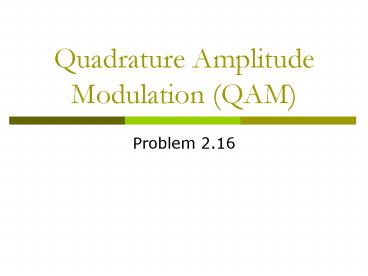Quadrature Amplitude Modulation QAM - PowerPoint PPT Presentation
1 / 14
Title:
Quadrature Amplitude Modulation QAM
Description:
Fourier Transform of h(n) infinite, bad for computation ... Multiplying by cos gives (reduced via identities) .5m1(t) .5[m1(t)cos(4pf0t) m2(t)sin(4pf0t) ... – PowerPoint PPT presentation
Number of Views:842
Avg rating:3.0/5.0
Title: Quadrature Amplitude Modulation QAM
1
Quadrature Amplitude Modulation (QAM)
- Problem 2.16
2
General Problem
- Two i.i.d (independent/identically distributed)
sequences put through a filter - h(n)
- (1/2)n, ngt 0
- 0 else
- Fourier Transform of h(n) infinite, bad for
computation - Need another form that is exact but finite
3
Z-transform
- Thus W(z)H(z) X(z)
- W(z) X(z)/H(z)
- W(z) X(z)/(1/(1-.5z-1)) X(z)-.5X(z)z-1
- W(z).5X(z)z-1 X(z)
- x(n) 1/2xn-1(n) w(n)
- Now have an exact finite form
- Can easily obtain xcn and xsn
h(n)
w(n)
x(n)
4
xcn and xsn
5
QAM
- Each message signal multiplied by a carrier wave,
then summed - cos(np/2) for primary
- sin(np/2) for quadrature
6
QAM, Continued
7
Autocorrelation
- Since signals are i.i.d, their autocorrelation
functions should be flat except near x0.
8
Autocorrelation, Cont.
9
Power Spectra
- Easy to calculate using autocorrelation
- i.e. Sc FRc
10
PSD
11
Power Spectral Density
- Alternate method of calculation
- Sc Fxc2
12
PSD, Continued
13
x(n) recovery
- Normally, need to multiply by cosine or sin
(depending on which signal you want) and then
lowpass the result. - Signal m1(t)cos(2pf0t) m2(t)sin(2pf0t)
- Multiplying by cos gives (reduced via identities)
- .5m1(t) .5m1(t)cos(4pf0t) m2(t)sin(4pf0t)
- Lowpass filter removes influence of m2(t)
- Repeat for sin(2pf0t)
- However, special case here need only multiply
by carrier signals
14
Recovery































